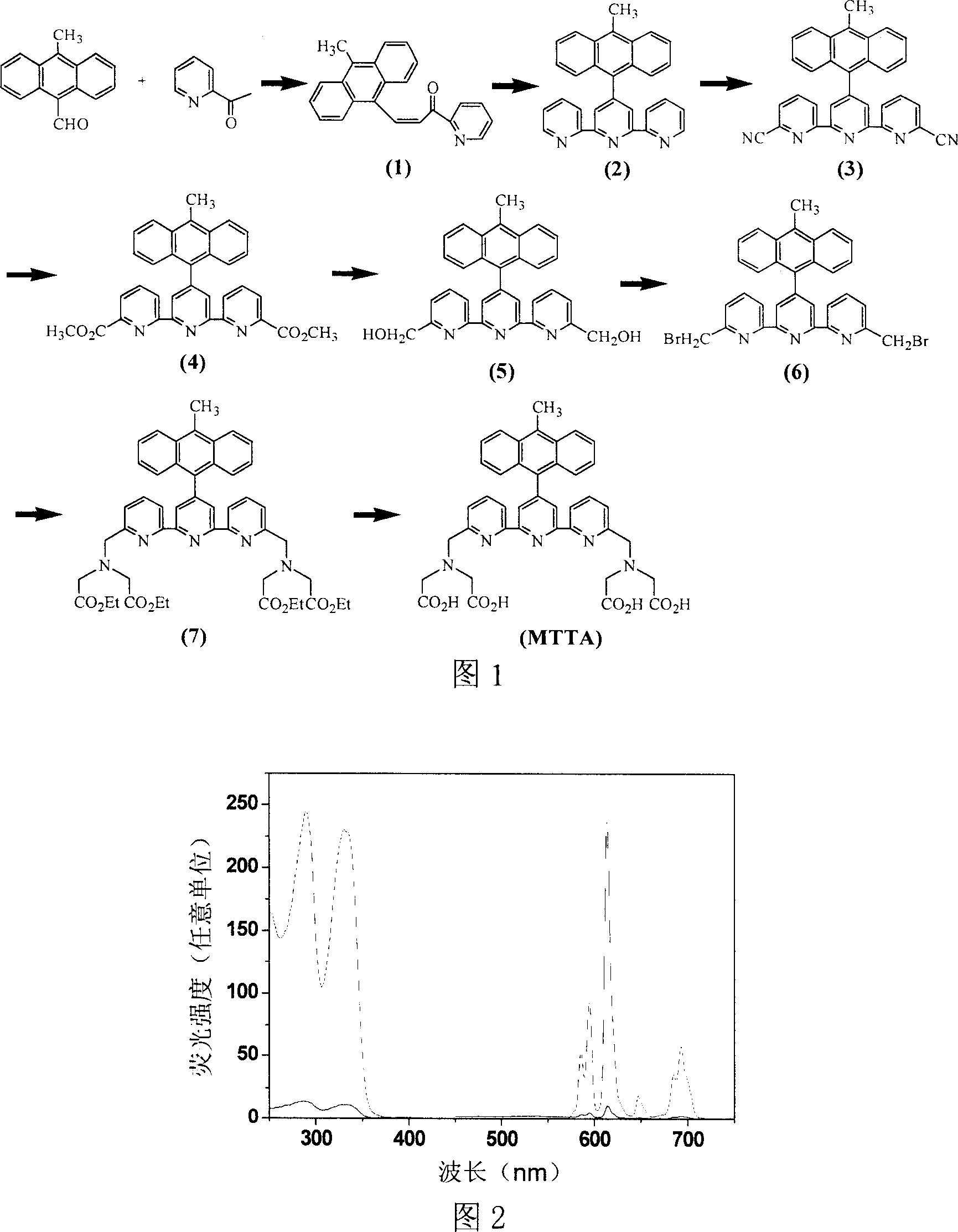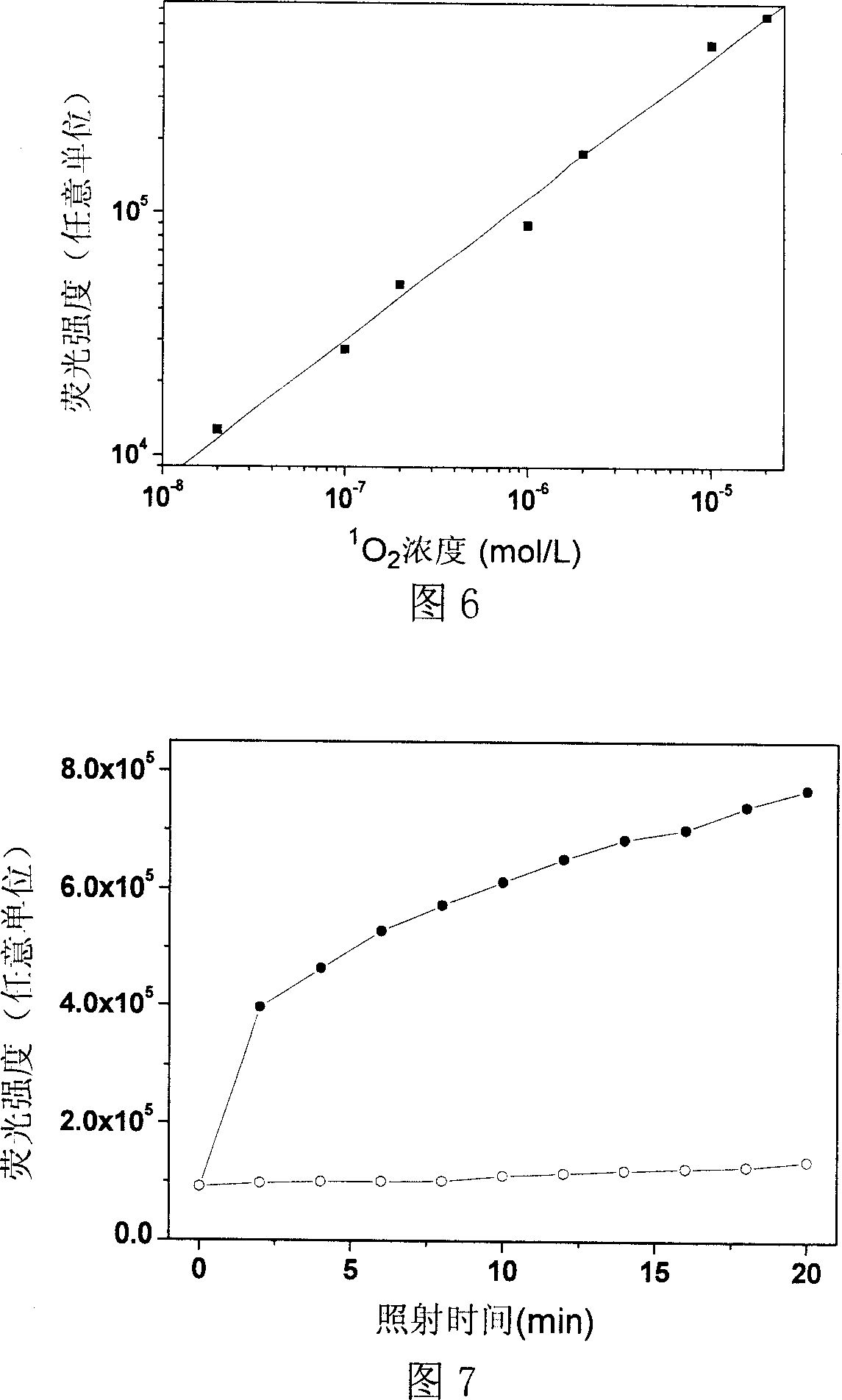Singlet oxygen fluorescence probe based on europium complex and its application
A technique of fluorescent probes and europium complexes, which is applied in the field of singlet oxygen measurement in living cells, can solve the problems of poor water solubility of probes, unfavorable measurement, and inability to use real-time measurement, and achieves high stability and enhanced fluorescence intensity. Effect
- Summary
- Abstract
- Description
- Claims
- Application Information
AI Technical Summary
Problems solved by technology
Method used
Image
Examples
Embodiment 1
[0030] Example 1. Ligand [4'-(10-methyl-9-anthracenyl)-2,2': 6'2”-bitripyridine-6,6”-dimethylamine]tetraacetic acid (abbreviation MTTA) synthesis.
[0031] The synthetic route is shown in Figure 1, and the matrix operation process is as follows.
[0032] (1) Synthesis of (E)-3-(10-methyl-9-anthryl)-1-(2'-pyridyl)-2-propenone (Compound 1)
[0033] After 11.01 g of 10-methyl-9-anthracene (50 mmol) and 2.81 g of KOH (50 mmol) are mixed and dissolved in a mixed solution composed of 150 ml of methanol and 30 ml of water, 6.06 g of 2-acetylpyridine (50 mmol) is slowly added dropwise In the reaction system, stir at room temperature for 24 hours. The precipitate was collected by filtration, washed thoroughly with ethanol and dried in vacuum to obtain 13.19 g of the target compound, yield: 81.6%. 1 HNMR(CDCl 3 ) Measurement results: δ = 3.15 (s, 3H); 7.48-7.57 (m, 5H); 7.92 (m, 1H); 8.23 (d, 1H); 8.30 (d, 1H); 8.34 to 8.40 (m, 4H) ); 8.69(d, 1H); 8.94(d, 1H).
[0034] (2) Synthesis of 4'...
Embodiment 2
[0049] Example 2. Probe MTTA-Eu 3+ And with 1 O 2 Combined with the internal oxide EP-MTTA-Eu 3+ Determination of the fluorescence properties of
[0050] (1) Fluorescence spectrum, fluorescence intensity and fluorescence lifetime
[0051] MTTA-Eu was measured using 0.05mol / L sodium borate buffer solution with pH 9.1 as the solvent 3+ The ultraviolet-visible spectrum, fluorescence spectrum, molar extinction coefficient (ε), fluorescence quantum yield (φ) and fluorescence lifetime (τ) in the solvent. EP-MTTA-Eu 3+ By MTTA-Eu 3+ With Na 2 MoO 4 / H 2 O 2 0.1mol / L NaHCO at pH 10.5 3 -Prepared in NaOH buffer solution (the product is verified by mass spectrometry), and then diluted 100 times with a 0.05mol / L sodium borate buffer solution with pH 9.1, and then determine its fluorescence properties in the solvent. The instrument for measuring the ultraviolet-visible spectrum is a Perkin Elmer Lambda35 spectrophotometer. The fluorescence measuring instrument is a Perkin Elmer LS 50B fluores...
Embodiment 3
[0059] Example 3. Using MTTA-Eu 3+ Quantitative determination of Na 2 MoO 4 / H 2 O 2 Produced by the system 1 O 2
[0060] 0.1mol / L NaHCO at pH 10.5 3 -Add MTTA-Eu to NaOH buffer solution separately 3+ (1.0μmol / L), Na 2 MoO 4 (1.0mmol / L) and a series of concentrations of H 2 O 2 (Every 2 molecules of H in the system 2 O 2 Produces 1 molecule 1 O 2 ). After the reaction was placed at 37°C, the reaction solution was subjected to time-resolved fluorescence spectrometry. The measuring instrument is a Perkin Elmer LS 50B fluorescence spectrophotometer.
[0061] As shown in Figure 5, with H 2 O 2 Concentration (i.e. 1 O 2 Concentration) increases, the fluorescence intensity of the probe also gradually increases, indicating that MTTA-Eu 3+ Can be used to quantitatively determine the 1 O 2 concentration. Figure 6 shows the use of MTTA-Eu 3+ Detection of Na 2 MoO 4 / H 2 O 2 Quantitatively produced in the system 1 O 2 Working curve. as the picture shows, 1 O 2The concentration and fluoresc...
PUM
 Login to View More
Login to View More Abstract
Description
Claims
Application Information
 Login to View More
Login to View More - R&D
- Intellectual Property
- Life Sciences
- Materials
- Tech Scout
- Unparalleled Data Quality
- Higher Quality Content
- 60% Fewer Hallucinations
Browse by: Latest US Patents, China's latest patents, Technical Efficacy Thesaurus, Application Domain, Technology Topic, Popular Technical Reports.
© 2025 PatSnap. All rights reserved.Legal|Privacy policy|Modern Slavery Act Transparency Statement|Sitemap|About US| Contact US: help@patsnap.com



